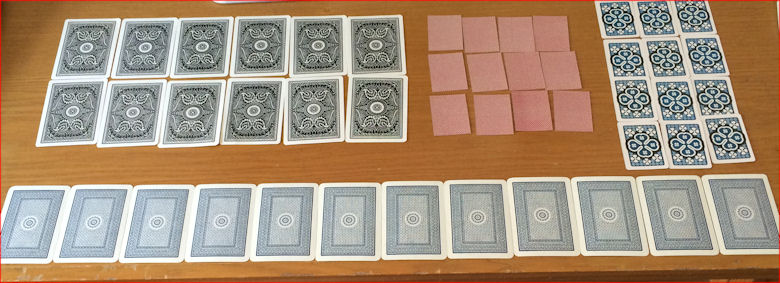

The more ways you can practice your times tables the better. Here are some ideas:
This is a game for two or more players. The pack of playing cards is dealt out among the players in face-down stacks as equally as possible1. The first player begins by repeatedly removing a card from the top of their stack and placing it face-up on a central pile. As they do so they should say the product of that card and the chosen times table. Let the Jack represent eleven and the Queen represent twelve.
The first player continues to ditch cards one by one until they get a King, an Ace or they make a mistake. At which point play passes to the next player on their left. The first player to ditch all of their cards is the winner.
This is an investigation for which it would be worthwhile recording the results. For the chosen times table each of the products is taken in turn and the challenge is to see how many different ways this number can be represented as a rectangle of playing cards.
This is a wonderful activity for the visual learner. Being able to construct rectangles for given numbers is the equivalent to knowing factors of that number and subsequently having a better knowledge of times tables facts.
Here is an example showing some of the ways 12 can be represented as a rectangle of cards:

You can try similar activities which are online and interactive: Time Tables Activities
1The time-honoured way of dividing a pack of cards 'roughly' in two but ensuring fairness is for one player to do the cut and the other person to choose which pile they will take.
If there are more than two players the method of cutting a cake could be adapted. The server slowly moves the knife along the cake, anyone can shout stop at any time and get the piece being cut off.
|
|
Do you have any wonderful ideas for using playing cards to help learn mathematics? Please share your ideas here. Playing cards have been around since the ninth century. They were invented in China and spread across Europe in the fourteenth century. Though the designs on the cards have changed over the years the basic number properties have not. Because they are so popular the manufacture of high quality cards is not expensive and makes them an ideal tool for learning mathematics. |
|
Ann Mason, Kingsmead School Derby
Tuesday, November 17, 2015
"NUMBER BONDS TO TEN
Remove all 10, j, q, k cards from a pack of cards.
Pupil turns over cards to create 8 separate piles.
Pairs of cards can be covered, with new cards from the pack, if the two numbers add up to 10. (Ace is taken as 1)
The aim is to get rid of all the cards - not always possible, but they soon learn to recognise the number bonds.
Could be timed to create competition as they get more confident."